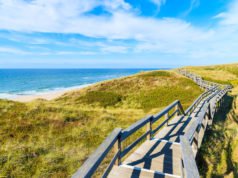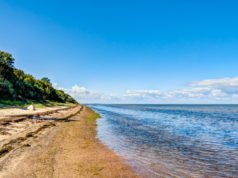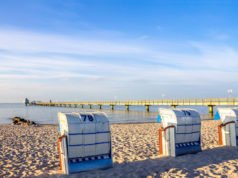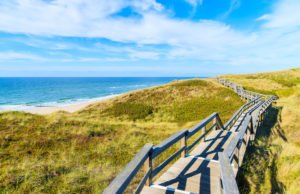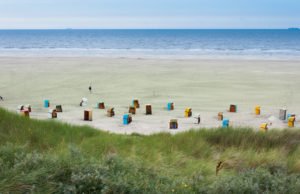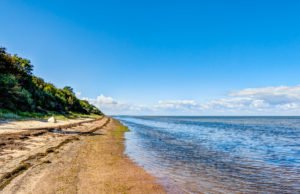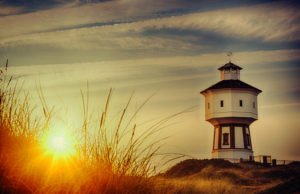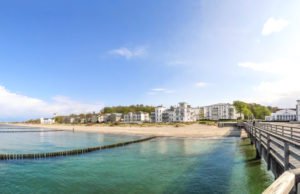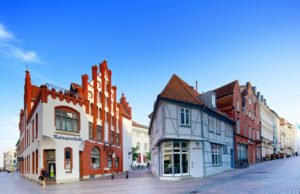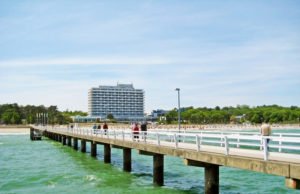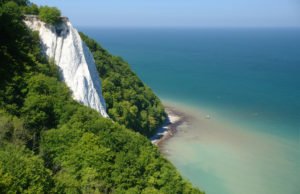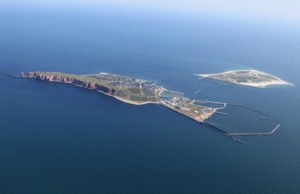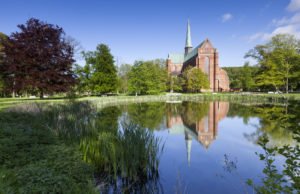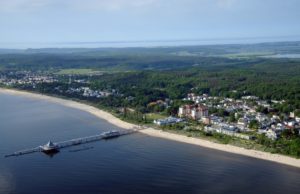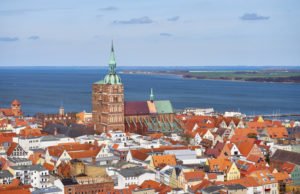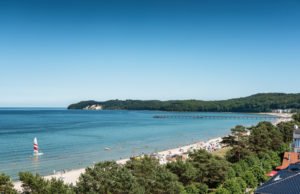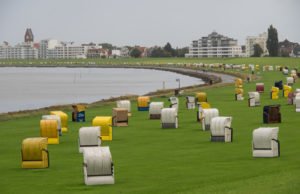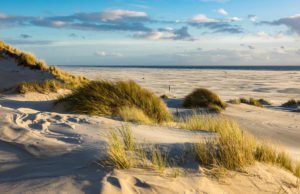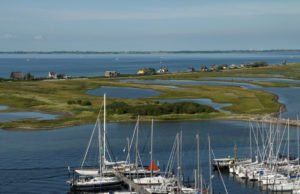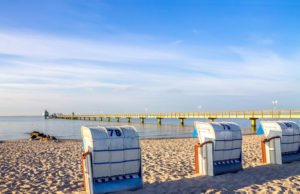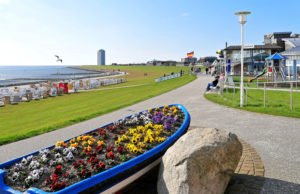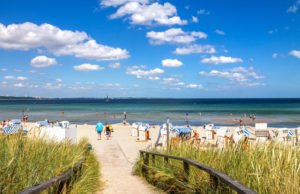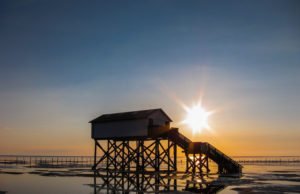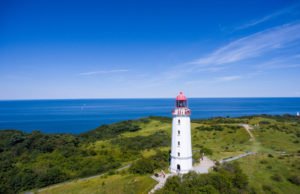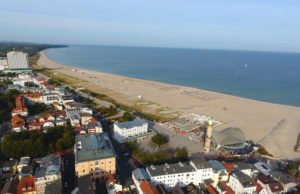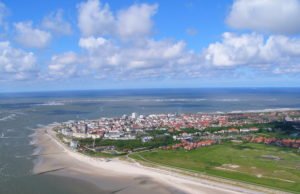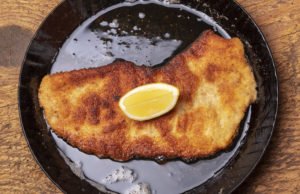Fischland-Darss-Zingst is a peninsula on the southern shore of the Baltic Sea in the German state of Mecklenberg-Western. Created by the tides and currents, the peninsula forms a barrier separating a lagoon from the open sea. The seaward side has some of Germany’s best beaches, while the quieter lagoon side has several little bays surrounded by reeds, forming a unique natural habitat for wildlife, and is now a protected national park.
The geography of the peninsular is constantly changing due to tidal erosion and sea currents. Sand is frequently carried away from the Fischland section and deposited on the Darsser Ort Promontory. Tourism has long been a source of income for the area, yet it is still far from being an overcrowded destination. It is also very popular with artists, who either live there permanently or visit regularly.
Biggest Villages
Zingst:

Prerow:

Wieck:

Ahrenshoop:

Wustrow:

Dierhagen:

Visitor attractions in Darss:
Darss Forest
The Darss area is famous for being a resting place for tens of thousands of migrating cranes and geese. Most of the area is covered by forest and dotted with small villages such as Born, Darss, Prerow and Wieck. The Forest and Western Lake is an unspoilt coastal area with a quiet beach. Three thousand years ago, the sea level was considerably higher and old cliff coastlines like Alte Meerufer (Old Seashore), can be found deep within the forest itself. The forest is also home to significant numbers of Red Deer and Roe Deer.

Western Pomerania Lagoon Area National Park
This is Mecklenberg-Vorpommern’s largest national park. It is situated at the coast of the Baltic Sea. It is characterised by very shallow water which is home to unique coastal fauna.
Darsser Ort lighthouse and museum
Darsser Ort is an extended chain of sandbanks running in a north easterly direction. Being in Protection Zone 1 of the Mecklenberg-Vorpommersche Boddenlandschaft National Park, it can only be visited on marked paths.

The Darsser Ort Lighthouse is the oldest active lighthouse in Mecklenberg-Western Pomerania, and is visible for up to 32 nautical miles at night. For more than 160 years, it has been a giant landmark on the rough coast and is now a listed building. It is surrounded by a few scrubby windswept trees called ‘windflucter’ which are characteristic of the area. There are 134 steps leading to the top of the lighthouse where you can see magnificent views of the Baltic sea and the ever changing landscape of Darsser Ort. On clear days, you can see as far as the Danish islands of Falster and Mon. The Natureum is an exhibition centre next to the lighthouse, showing the history of the peninsular. After looking around, why not treat yourself in the museum cafe? The lighthouse can be reached by foot, bicycle or horse drawn carriage. It is open daily May-October.
Natureum in Wieck
This is a satellite of the German Oceanographic Museum at Stralsund. It is located 5 km northwest of Prerow in the middle of the Western Pomerania Lagoon National Park. It can be reached on foot, by bicycle or horse and cart, though a bus can be made available on request. The focus of the area is the nature and landscape of the Darss Peninsular. Through the use of taxidermy, wildlife specimens such as porpoise, seal and eider duck can be seen, along with a Baltic Sea aquarium.
Ahrenshoop Art Museum
This architecturally unusual building which picks up on regional characteristics, houses a collection of paintings, sculptures and graphics by artists who have lived, worked or visited Ahrenshoop or nearby places. Open daily from April to October. A small entry fee is payable.
Wustrow Church
This is a nineteenth century Gothic Revival brick church with an 18 metre high steeple. It provides panoramic views over the peninsula.

Zingst Local Museum
This museum displays art, local history, model ships, history of shipbuilding and navigation.
Fisherman’s Houses
The area is dotted with picturesque homes inhabited by local people. The roofs are thatched with reeds and the houses are painted in a variety of bright colours. A lovely photo opportunity.
Gut Darss
Great for kids and adults, Gut Darss is an organic farm, with sheep, cattle, horses and a petting zoo where you can feed the goats. There is a climbing forest with various levels of difficulty from beginners to advanced, a miniature golf course and a playground. There are giant tractors, and an easy to use electric excavator on the site for young children to operate. The farm cafe and restaurant serves traditional, local dishes such as organic buffalo burgers, homemade sausages, and home produced steaks as well as their own locally produced beer. The farm shop sells delicious, locally produced food. A wild boar barbecue buffet is available twice a week from May to October.
Other activities in the area include cycling, horse riding, diving, sailing, kitesurfing and birdwatching, or you can take a trip on a traditional zeesenboot.
Best time to visit to Darss
May to October is probably best since most activities and attractions are open at this time and the weather is more suitable for outdoor activities.
Eating in Darss:
Aiming to maintain and nurture the culinary traditions of the area, many of the ingredients are gathered from the wild. While the coastal location influences the cuisine, the food in this region is typical German country fare. Simply prepared dishes using local ingredients such as fresh fish and locally produced meat are usual.
Roast wild boar, with wild herbs and mushrooms, seitan stir-fry, smoked fish and meats, locally made sausages and burgers from organic meat, can all be seen on the menus. Local tea specialities such as Herrentoffee, Wintermarchen, Leuchtfeuer or Schietwetter-Tee are available, along with Bullenbrau beer, and a local liqueur made from sea buckthorn.
Binnen un Buten is a popular fish restaurant, in nearby Prerow and has a beer garden. While Eichenstubchen located in Darss, is a rustic tavern selling down to earth, delicious German and Ukraine cuisine. Cafe Buhne is a restaurant serving mainly fish dishes. It is directly on the steep coast and has a terrace offering amazing sea views. Visit in the evening and watch the sun setting.

Where to stay in Darss:
There is a significant number of rental properties (over 300) in the region varying from houses, pensions, apartments and hotels, from around €45 to €150. Nearly every house on the peninsula offers at least one room or holiday flat for rent. Just look out for the Zimmer Frie or FeWo frie signs. Alternatively, the tourist information offices of each of the boroughs keep a list and are usually informed of vacancies.
Ostseehotel Wustrow is a family owned hotel directly on the beach. It offers cycle rental and there is a beautician and massage service available. A double room costs around €30 — €70, and a holiday flat will cost about €45 — €120.
Hotel Restaurant Marks in Zingst, is a small family owned establishment with just 25 rooms. A double room will cost around €55 — €130.
Steigenberger Strandhotel and Spa is also in Zingst. This is a plush hotel directly on the beach near the pier.
There are campsites in Prerow, Zingst and Born. Each municipality charges a visitor tax of €1 — €3 per day depending on the season. This allows visitors free or reduced admission to some public facilities and events.
Public transport in Darss:
The nearest rail stations are Ribnitz-Damgarten on the mainland end of the Fischland isthmus and Velgast which is closer to the Zingst Bridge. Both stations are served by high speed intercity trains from Hamburg, Rostock and Stralsund every two hours. There are also links from Bremen, Hanover, Cologne and Stuttgart.
From Ribnitz-Damgarten the 210 bus crosses the whole peninsula stopping at each of the boroughs. From Velgast you need to take the ‘UBB’ train to Barth where you can catch the 210 bus. The most convenient method is to travel by car.
The nearest airport is Rostock-Laage, around 80 km southwest of the peninsula.
There is only one main road for cars so cycling is a popular option. Most guesthouses either have bicycles for rent or there is a cycle hire place nearby. The landscape is flat, with many well paved and signposted cycle paths. With the beautiful views, cycling is an ideal way to explore the area. During bad weather, you can explore by taking the hourly 210 bus that links all the townships.
Shopping in Darss:
Each of the boroughs has dozens of small shops selling clothing, accessories, art, souvenirs, and there is at least one small supermarket in each town. Farm shops sell local produce. A larger supermarket can be found at Dierhagan where there is a large Edeka and an Aldi discount store.
Bunte Stube is a popular well stocked bookshop, selling titles mainly on art and culture. It is a traditional meeting point for local artists, visiting artists and the arty public. Exhibitions and performances are sometimes held in the sales room.
Off the beaten path in Darss:
For a day out with a difference, what could be better than a fungal foray in Prerow? Go along with an experienced guide and pick your own oyster mushrooms, bay boletes, and russula. The original forest and meadows of the Darss peninsula are ideal for the growth of these delicious treats. Tours are available September – October.
Alternatively, why not take a wild herb tour? From early spring until well into autumn, herbs, flowers leaves, berries, shrubs and trees provide edible tidbits or ingredients that can be used in teas or beauty products. Available March – October.


